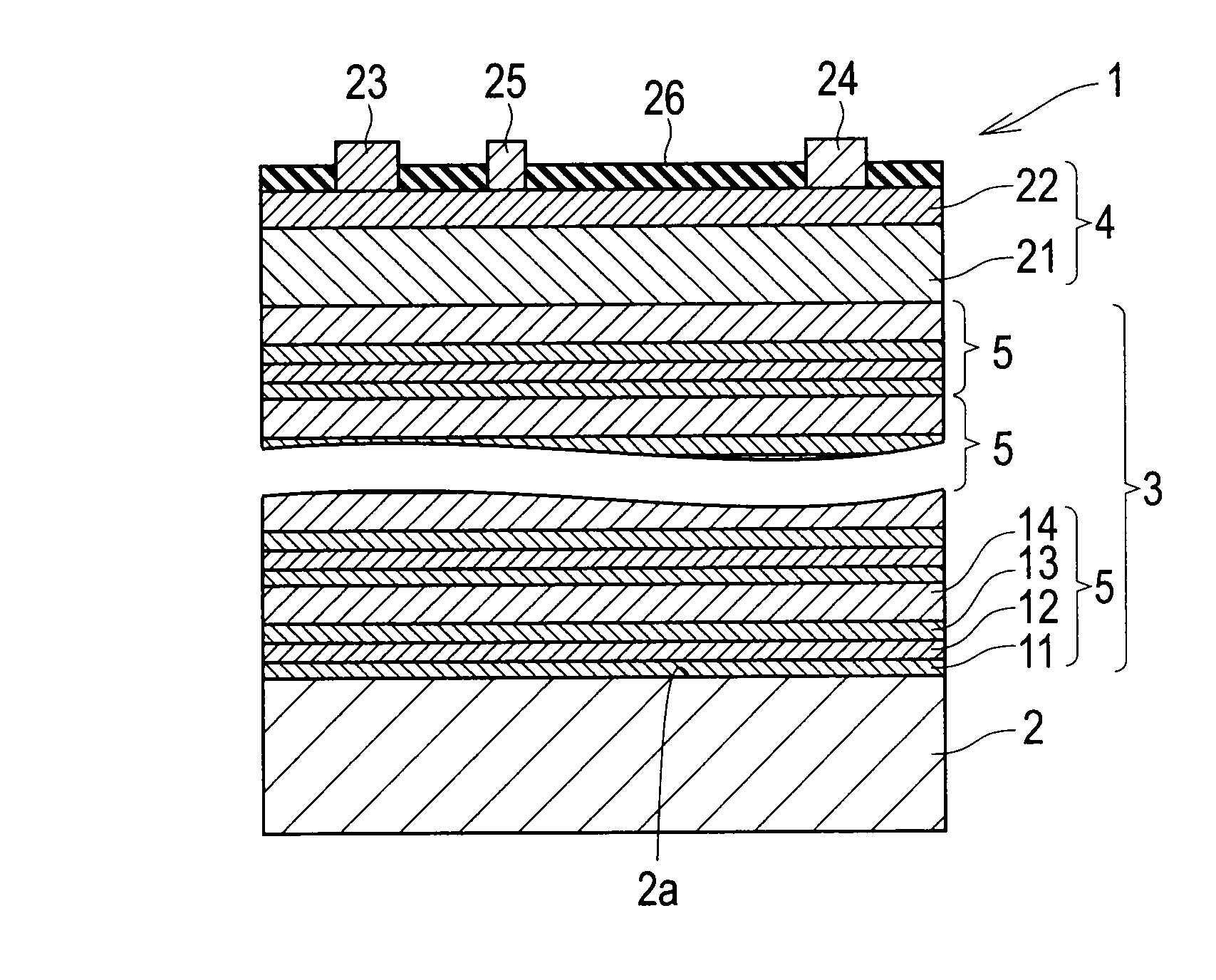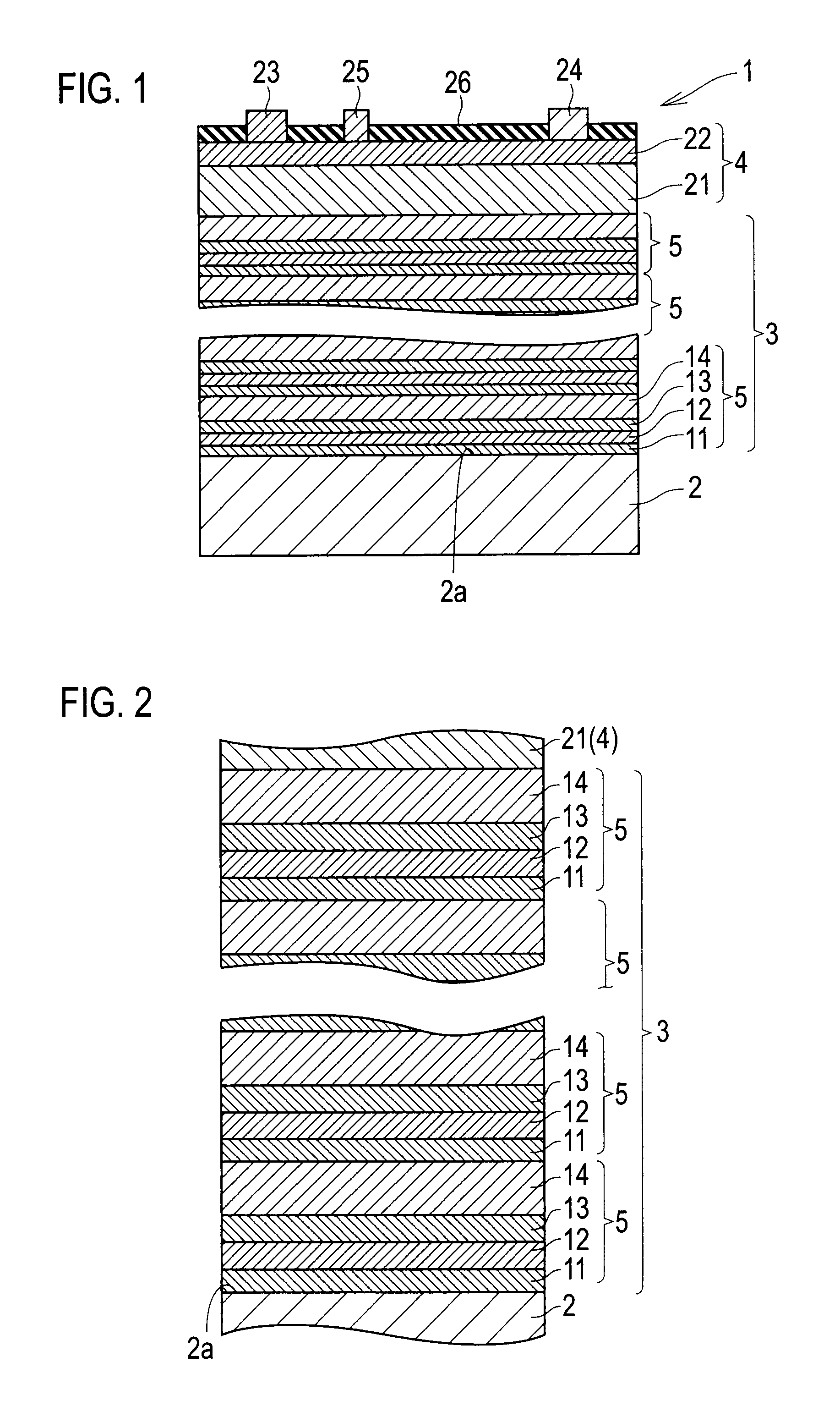Semiconductor device
a technology of semiconductors and devices, applied in semiconductor devices, electrical devices, transistors, etc., can solve problems such as disadvantageous cracks, and achieve the effects of suppressing cracks, reducing the change amount of lattice constants, and improving the stress relaxation effect of the second composition graded layer
- Summary
- Abstract
- Description
- Claims
- Application Information
AI Technical Summary
Benefits of technology
Problems solved by technology
Method used
Image
Examples
first embodiment
[0027]A first embodiment in which a semiconductor device according to the present invention is applied to an HEMT (high electron mobility transistor) is described with reference to the drawings. FIG. 1 is a cross-sectional view of the semiconductor device according to the first embodiment. FIG. 2 is a cross-sectional view of a buffer layer. FIG. 3 is a graph showing a relationship between thicknesses of constituent layers of the buffer layer and Al content rates of the constituent layers.
[0028]As shown in FIG. 1, a semiconductor device 1 according to the first embodiment includes a substrate 2, a buffer layer 3, and a device formation layer 4.
[0029]The substrate 2 supports the buffer layer 3 and the device formation layer 4. The substrate 2 is made of n-type monocrystalline silicon containing n-type impurities of a group V element such as P (phosphorus).
[0030]The buffer layer 3 functions to relax a stress resulting from a difference in lattice constant between silicon constituting t...
second embodiment
[0065]A second embodiment in which a buffer layer differs from the buffer layer according to the first embodiment is described next. FIG. 4 is a cross-sectional view of the buffer layer according to the second embodiment. FIG. 5 is a graph showing a relationship between thicknesses of constituent layers of the buffer layer and Al content rates of the constituent layers. Like constituent elements as those according to the first embodiment are denoted by like reference signs and descriptions thereof will be omitted.
[0066]As shown in FIGS. 4 and 5, in the buffer layer 3 according to the second embodiment, thicknesses d1m and d2m of first and second composition graded layers 12m and 14m closer to the substrate 2 are smaller than thicknesses d1m and d2m of first and second composition graded layers 12m and 14m closer to the device formation layer 4, respectively. It is assumed that m=1, 2, . . . n.
[0067]That is, the first and second composition graded layers 12m, and 14m are formed so th...
third embodiment
[0072]A third embodiment in which a buffer layer differs from those according to the above embodiments is described next. FIG. 6 is a graph showing a relationship between thicknesses of constituent layers of the buffer layer according to the third embodiment and Al content rates of the constituent layers. Like constituent elements as those according to the above embodiments are denoted by like reference signs and descriptions thereof will be omitted.
[0073]As shown in FIG. 6, in the buffer layer 3 according to the second embodiment, thicknesses d1m and d2m of first and second composition graded layers 12m and 14m closer to the substrate 2 are larger than thicknesses d1m and d2m of first and second composition graded layers 12m and 14m closer to the device formation layer 4, respectively.
[0074]That is, the first and second composition graded layers 12m and 14m are formed so that the thicknesses d1m and d2m satisfy, respectively:
[0075]d11>d12> . . . >d1n, and
[0076]d21>d22> . . . >d2n. ...
PUM
 Login to View More
Login to View More Abstract
Description
Claims
Application Information
 Login to View More
Login to View More - R&D
- Intellectual Property
- Life Sciences
- Materials
- Tech Scout
- Unparalleled Data Quality
- Higher Quality Content
- 60% Fewer Hallucinations
Browse by: Latest US Patents, China's latest patents, Technical Efficacy Thesaurus, Application Domain, Technology Topic, Popular Technical Reports.
© 2025 PatSnap. All rights reserved.Legal|Privacy policy|Modern Slavery Act Transparency Statement|Sitemap|About US| Contact US: help@patsnap.com



